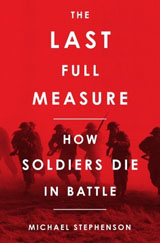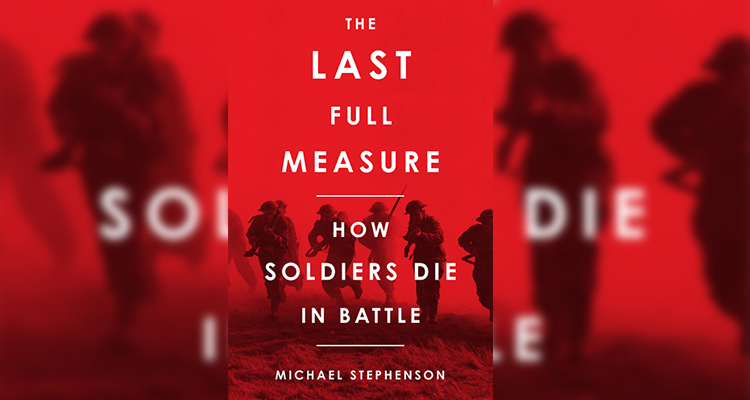
The Last Full Measure
How Soldiers Die in Battle
By Michael Stephenson. 480 pp.
Crown, 2012. $28.
Reviewed by Steven Trent Smith
SHOOTING. STABBING. Exsanguinating. Slashing. Trampling. Crushing. Atomizing. Burning. Disease. Drowning. Asphyxiating. Friendly fire. Suicide. Those are some of the ways soldiers die in battle. Spears, lances, swords, arrows, bayonets, balls, bullets, grapeshot, gas, mines, shells (armor piercing and high explosive), rockets, and IEDs. Those are some of the weapons used over millennia to kill those soldiers.
Michael Stephenson’s The Last Full Measure chronicles these methods and tools, from the early Greek wars to Iraq and Afghanistan today—a vast period of military history compressed into a very dense read. Each of the seven chapters examines recurring themes through the ages: strategy, tactics, logistics, leadership, behavior, and most exhaustively, weaponry. To illuminate these themes, the author makes use of letters and memoirs offering intimate glimpses of what it’s like in the muck and mire and establishing the emotional toll war extracts. Often revealing, these quotes nonetheless tend to overwhelm the narrative by their frequency and redundancy.
That said, the mythologies of honor and heroism are dominant leitmotifs, and Stephenson’s analysis of their roles in war (and in death) is perceptive. In Roman times, “virtus, the combination of courage, daring, and determination to close with the enemy, was highly prized.” Sadly, with the advent of mechanized war in the 20th century, soldiers often died without even a glimmer of heroic dignity.
Stephenson also gives fear—fear of fighting, of dying, of being crippled—deserved attention. During World War I the weapon feared most was artillery, which Stephenson says “had a ravenous and capricious appetite” and “devoured men in body and spirit.”
The passages about how soldiers have coped with fear are instructive. Throughout the ages some have used talismans to ward off death; “superstitious tics” or pre-battle rituals were common. Other men resigned themselves to the inevitability of being killed. “Resignation was a kind of liberation,” writes the author, “a calmness in the face of almost certain obliteration.”
The Last Full Measure is packed with statistics, which frame the cost of war in absolute terms. But at times the numbers blur. While the writing gets the job done, it is less than eloquent, and there are some odd usages. “Fragged,” a word coined during the Vietnam War to denote the assassination of an officer (by fragmentation grenade), is first used in the book (and not defined) to describe an incident in the British Army in 1704. The Indian Wars were “slugfests.” And there are too many references to soldiers being on the “sharp end.”
It’s disappointing that in the final chapter Stephenson does not address the deaths of women soldiers and Marines in Iraq and Afghanistan. While forbidden from direct combat, women in these conflicts nevertheless work in such proximity to the amorphous front lines that at least 144 have paid the ultimate price.
Exhaustively researched, The Last Full Measure succeeds as a serious and thoughtful study of an aspect of war few writers have ever explored at length. Just be prepared for a slugfest in a thicket of subjects, words, and numbers.
Steven Trent Smith, a frequent contributor to MHQ, is the author of two books on World War II in the Pacific: The Rescue and The Wolfpack (available on Kindle).






